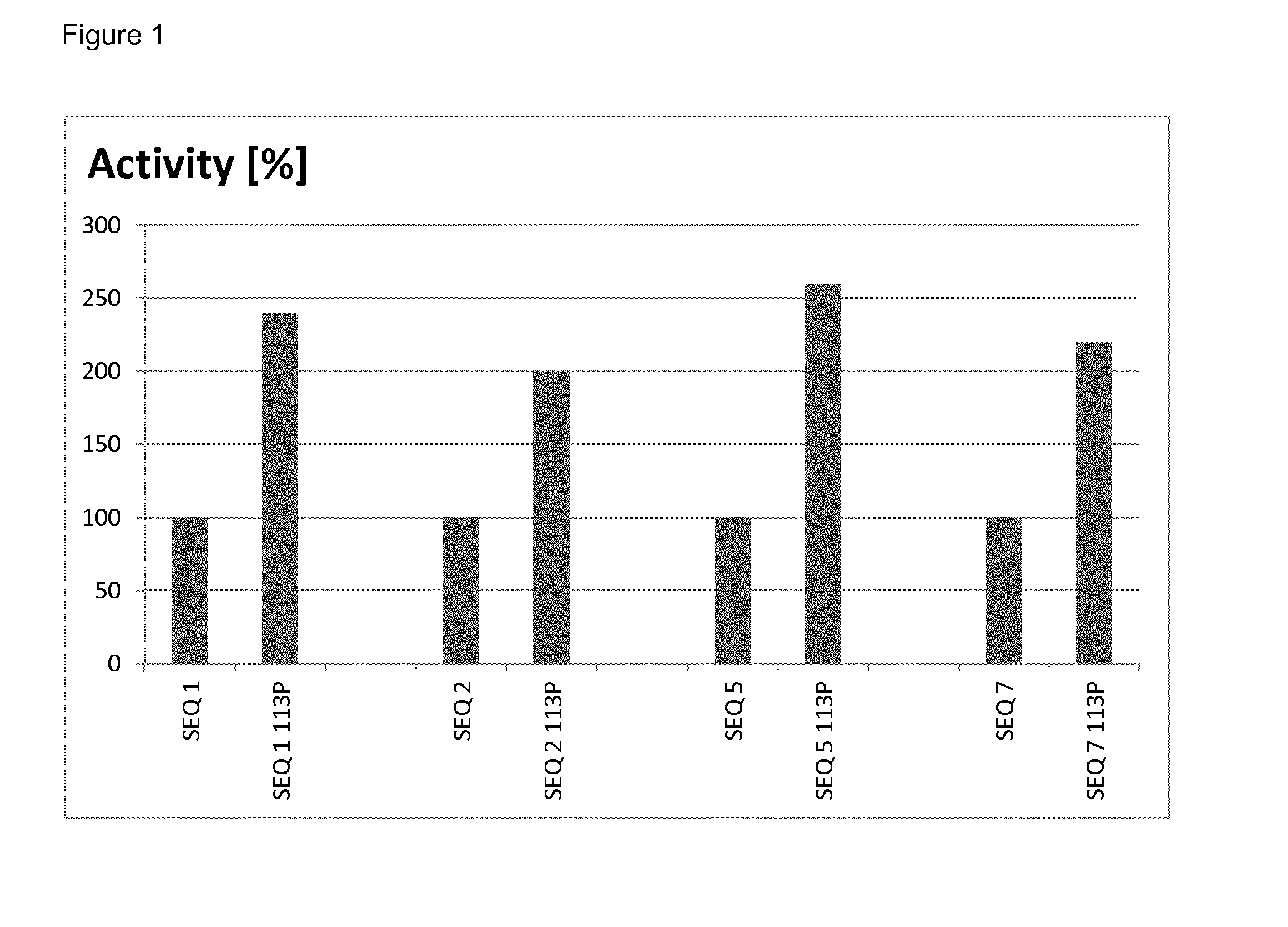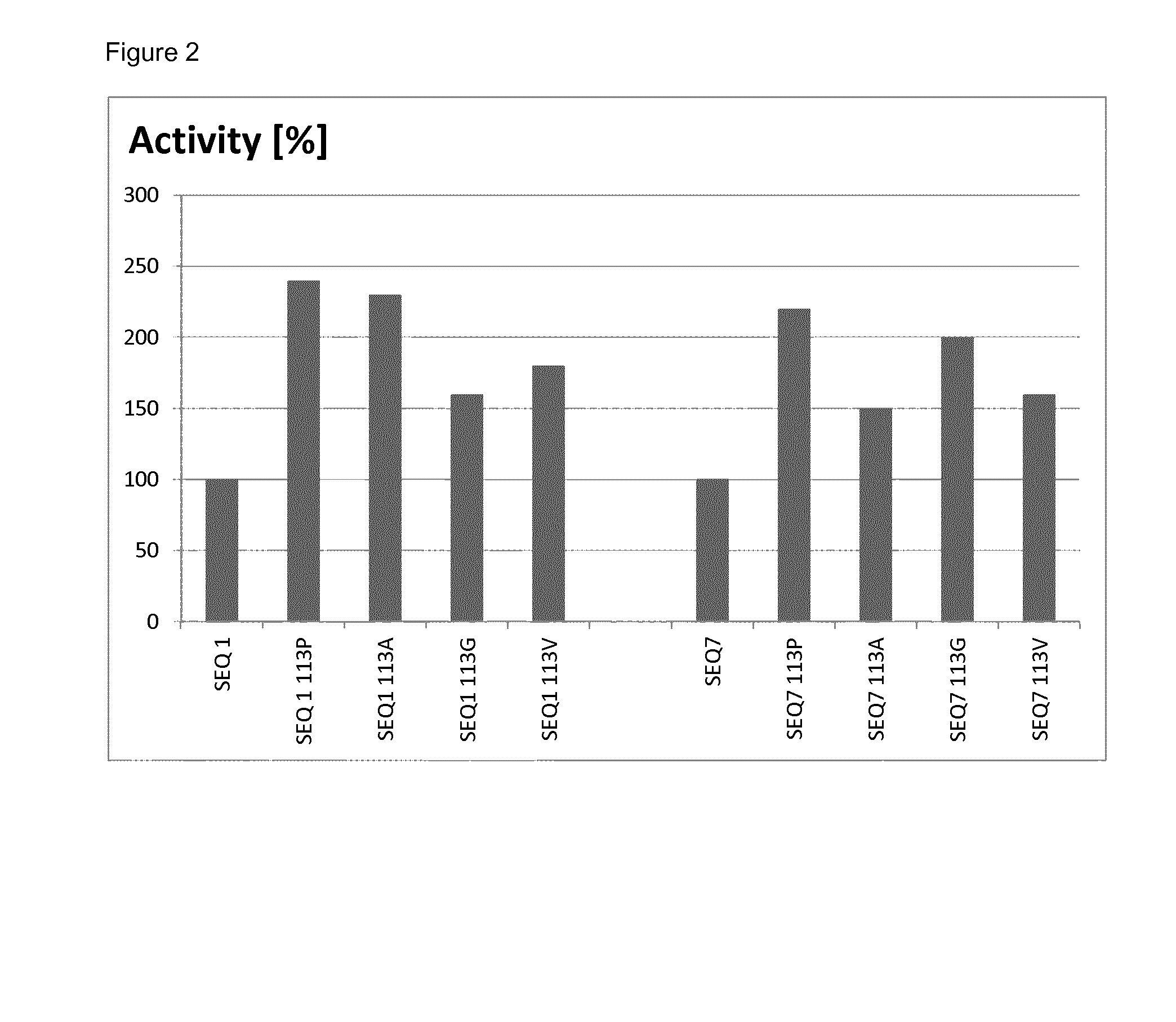Laccase variants with improved properties
a technology of a variant and a protein, applied in the field oflaccase variants, can solve the problems of unpredictable foldability of different proteins in bacteria, limited recombinant protein yield in bacterial hosts, and high cost, and achieve the effect of improving the yield of a polypeptid
- Summary
- Abstract
- Description
- Claims
- Application Information
AI Technical Summary
Benefits of technology
Problems solved by technology
Method used
Image
Examples
example 1
Construction of Laccases with Improved Properties
[0083]Mutations as described herein were introduced into various recombinant genes by standard site-directed mutagenesis essentially as described in WO 2013 / 038062. In more detail, in order to introduce mutation 113P into the gene of SEQ ID NO: 1, two separate PCRs were carried out:
(1) with primers Primer1(SEQ ID NO: 15)GAAATTAATACGACTCACTATAGGandPrimer 2 (Seq1)(SEQ ID NO: 16)TGGCGTGACGCCTCCGTGTAAATGAACGAC,(2) with Primer3 (Seq1)(SEQ ID NO: 17)TACACGGAGGCGTCACGCCAccgGATAGTGACGGandPrimer4(SEQ ID NO: 18)GGTTATGCTAGTTATTGCTCAGCGGTG.
[0084]In both reactions, recombinant gene without the mutation was used as the template. Primers1 and 4 bind inside the vector sequence and are not specific to the recombinant gene. Primers2 and 3 bind inside the recombinant gene and their binding sites overlap. Primer3 binding site contains the mutation site. Primer3 represents the mutated (desired) sequence, which is not 100% matching the template (lower cas...
example 2
Heterologous Expression of Variant and Non-Mutated Laccases
[0090]Variant laccases were expressed in E. coli and Pichia pastoris.
[0091]For expression in Pichia Pastoris, recombinant genes were cloned into a commercial Pichia Pastoris expression vector pPICZ-A, available from Invitrogen (Life Technologies). This vector provides secreted protein expression under the control of methanol-inducible AOX1 promoter upon integration of the construct into genomic DNA of the yeast cell.
[0092]Linearized plasmid DNA was introduced into yeast cells by electroporation, and clones with integrated recombinant gene were selected on agar medium plates with Zeocin (25 μg / ml). Ten colonies from each construct were tested in small liquid cultures (3 ml) with a 72-hour cultivation in humidified shaker at 28° C. according to the plasmid manufacturer manual (http: / / tools.lifetechnologies.com / content / sfs / manuals / ppiczalpha_man.pdf). The medium recommended by the manufacturer was supplemented with 1 mM CuCl, ...
example 3
Measurement of Yield
[0094]The relative yields of mutated and non-mutated soluble laccases were determined by densitometry of protein bands after denaturing polyacrylamide gel electrophoresis. To this end, samples of soluble proteins after thermal treatment (see Example 2) obtained from parallel cultures of mutated and non-mutated clones, were analyzed by gel-electrophoresis under denaturing conditions (a standard method well known in the art of molecular biology). After staining the gel with Coomassie Brilliant Blue, the gel was scanned to obtain a bitmap image, and intensity of the band corresponding to recombinant laccase was quantified by ImageJ software (a public freeware developed at National Institute of Health and online available at http: / / imagej.nih.gov / ij / ).
PUM
| Property | Measurement | Unit |
|---|---|---|
| pH | aaaaa | aaaaa |
| nucleic acid | aaaaa | aaaaa |
| non-polar | aaaaa | aaaaa |
Abstract
Description
Claims
Application Information
 Login to View More
Login to View More - R&D
- Intellectual Property
- Life Sciences
- Materials
- Tech Scout
- Unparalleled Data Quality
- Higher Quality Content
- 60% Fewer Hallucinations
Browse by: Latest US Patents, China's latest patents, Technical Efficacy Thesaurus, Application Domain, Technology Topic, Popular Technical Reports.
© 2025 PatSnap. All rights reserved.Legal|Privacy policy|Modern Slavery Act Transparency Statement|Sitemap|About US| Contact US: help@patsnap.com



